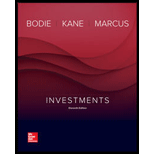
Concept explainers
To determine:
Three concepts of behavioral finance which is demonstrated in the comments of Pierce and explain each concept. Discuss how these concepts will be challenged by the investor practicing traditional or standard finance.
Introduction:
Overconfidence refers to the behavioral bias which stand dangerous, especially in the financial markets. It was assumed that overconfidence does not impact the investor, however the more the investor is overconfidence the more it will impact. In other words, it depicts underestimation of risk, overestimation of knowledge and exaggerating the ability of controlling the events.
Loss aversion reflects the tendency of the people to avoid incurring losses for earning equivalent amount of gains. For instance the investors that possess behavioral characteristics of loss aversion find it optimum to find $5 but not to lose $5. This principle also stands important in economics domain.
Reference point stands to be one of the keys in the world of behavioral finance to understand that the outcomes are evaluated by the people in relation to a relative point and then the classification of loss and gain is done.
Want to see the full answer?
Check out a sample textbook solution
Chapter 12 Solutions
Investments
- Which of the following is considered a long-term financing source for a company?A) Accounts PayableB) Common StockC) Short-term loansD) Accrued Expensesarrow_forwardWhich of the following best defines the term "capital structure"?A) The way a company raises its capital through debt and equityB) The investment decisions made by a companyC) The amount of profit a company generatesD) The distribution of earnings to shareholdersneed helparrow_forwardWhich of the following is considered a long-term financing source for a company?A) Accounts PayableB) Common StockC) Short-term loansD) Accrued Expensesarrow_forward
- Which of the following best defines the term "capital structure"?A) The way a company raises its capital through debt and equityB) The investment decisions made by a companyC) The amount of profit a company generatesD) The distribution of earnings to shareholdershelparrow_forwardWhich of the following best defines the term "capital structure"?A) The way a company raises its capital through debt and equityB) The investment decisions made by a companyC) The amount of profit a company generatesD) The distribution of earnings to shareholdersarrow_forwardThe time value of money concept is based on the idea that: A) Money loses value over timeB) Money has the same value over timeC) The value of money increases over time due to inflationD) A dollar today is worth more than a dollar in the futurehelparrow_forward
- The time value of money concept is based on the idea that: A) Money loses value over timeB) Money has the same value over timeC) The value of money increases over time due to inflationD) A dollar today is worth more than a dollar in the future explain.arrow_forwardThe time value of money concept is based on the idea that: A) Money loses value over timeB) Money has the same value over timeC) The value of money increases over time due to inflationD) A dollar today is worth more than a dollar in the futurearrow_forwardWhich of the following is the most appropriate metric for determining a company's profitability?A) Return on Assets (ROA)B) Debt-to-Equity RatioC) Price-to-Earnings (P/E) RatioD) Current Ratio need helparrow_forward
- Which of the following is the most appropriate metric for determining a company's profitability?A) Return on Assets (ROA)B) Debt-to-Equity RatioC) Price-to-Earnings (P/E) RatioD) Current Ratio explain.arrow_forwardWhich of the following is the most appropriate metric for determining a company's profitability?A) Return on Assets (ROA)B) Debt-to-Equity RatioC) Price-to-Earnings (P/E) RatioD) Current Ratioarrow_forwardWhat does the term "liquidity" refer to in financial management?A) The profitability of a companyB) The ease with which an asset can be converted into cashC) The long-term sustainability of a companyD) The company's capital structure helparrow_forward
 Essentials Of InvestmentsFinanceISBN:9781260013924Author:Bodie, Zvi, Kane, Alex, MARCUS, Alan J.Publisher:Mcgraw-hill Education,
Essentials Of InvestmentsFinanceISBN:9781260013924Author:Bodie, Zvi, Kane, Alex, MARCUS, Alan J.Publisher:Mcgraw-hill Education,

 Foundations Of FinanceFinanceISBN:9780134897264Author:KEOWN, Arthur J., Martin, John D., PETTY, J. WilliamPublisher:Pearson,
Foundations Of FinanceFinanceISBN:9780134897264Author:KEOWN, Arthur J., Martin, John D., PETTY, J. WilliamPublisher:Pearson, Fundamentals of Financial Management (MindTap Cou...FinanceISBN:9781337395250Author:Eugene F. Brigham, Joel F. HoustonPublisher:Cengage Learning
Fundamentals of Financial Management (MindTap Cou...FinanceISBN:9781337395250Author:Eugene F. Brigham, Joel F. HoustonPublisher:Cengage Learning Corporate Finance (The Mcgraw-hill/Irwin Series i...FinanceISBN:9780077861759Author:Stephen A. Ross Franco Modigliani Professor of Financial Economics Professor, Randolph W Westerfield Robert R. Dockson Deans Chair in Bus. Admin., Jeffrey Jaffe, Bradford D Jordan ProfessorPublisher:McGraw-Hill Education
Corporate Finance (The Mcgraw-hill/Irwin Series i...FinanceISBN:9780077861759Author:Stephen A. Ross Franco Modigliani Professor of Financial Economics Professor, Randolph W Westerfield Robert R. Dockson Deans Chair in Bus. Admin., Jeffrey Jaffe, Bradford D Jordan ProfessorPublisher:McGraw-Hill Education





